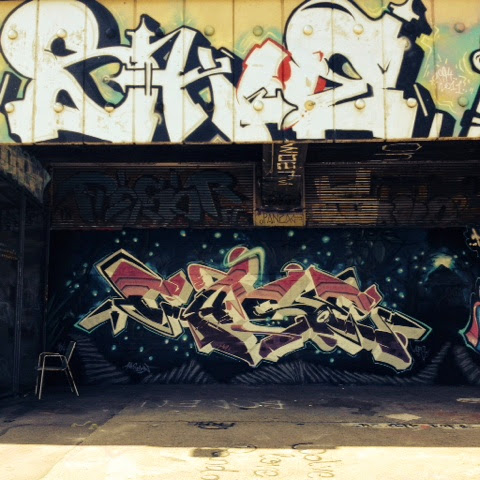Fuchs, Hundertwasser, Ottakringer & Street Art
Veered off the path of exploring imperial and classical Vienna art and architecture and rambled into the colorful side streets. Began with a trip to the Otto Wagner haus in the 16th district. Wagner, 1841-1918, was a Jungendstil (art nouveau) architect. He designed this house for his family. When it was finished in 1890, a Berlin press release noted that "a strange allure is evoked by this peculiar villa....completely deviating from the appearance of similar buildings, the frontal view of the house that sits on the flank of the hill, only shows a large open hall between two side wings."

Strange indeed, as when Rachel and I tried to press the bus driver for the name of the stop, although he drives past it several times a day, he denied any knowledge of it. We pointed it out to him as we disembarked and he still looked at us as though he simply did not see it. (The sculpture is one of Fuchs' contributions.)

During the years Wagner lived there, he regularly entertained Viennese high society, including architect Adolf Loos, composer Gustav Mahler and the artist Gustav Klimt. The house was subsequently bought by a Viennese businessman and then fell into disrepair and decay. Ernst Fuchs, also attracted by the strange allure, had his eye on the house for a long time, thinking he might buy it for his mother and then eventually procuring it for a studio. It took him two years to restore it. Thankfully, the magnificent Tiffany windows were intact and Fuchs preserved as much of Wagner's design as he could, adding his own naturalist, surrealist and fantastical details to the exterior and grounds. He filled the interior with his own designs: the furniture, wallpaper, tapestries, chandeliers, sculptures and of course his own drawings and floor-to ceiling oil paintings.
Note the mosaic eyeballs on the top rim and the snakes seething out of the bowl.
The rat on shoulder and gold sneakers set her apart from other girls.
His son, who does a lot of mosaic work, has a studio on the property as well and helped with many of the embellishments.
Fuchs designed this chandelier and had it made in Venice. The Ernst Fuchs museum website has photos of all of the rooms.
Fuchs built a remarkable fountain, using thousands of pieces of Tiffany glass for the pool bottom.
Where's Waldo? At the side of the fountain house.
Front of the fountain house
Iridescent stained glass comprises the bottom of the pool.
Fuchs was first publicly recognized for his charcoal drawings at age 15 in 1945 and went on to become a renowned painter, sculptor, printer, stage designer for the Hamburg and Munich opera houses, furniture builder, poet, lyricist, singer... you name it. He helped form the Art Club in Vienna in 1946, an association organized to question the recent stringent Nazi dictates of the ideas for art, championing an an artist's autonomy instead.
He became known over the years as a founder of the School of a Fantastic Realism, a style of expression distinguished by the refined skills of traditional painting, but painting or creating scenes with unusual juxtaposition.
Rachel, who attends the School of Visionary Art here in Vienna, met him recently at his 84th birthday party; he is still a forceful figure and is still creating.
Celebrating Ottakringer's 177th birthday. In the background, typical Austrian man in his fishing vest drinking beer.
Urban or street art is legal in Vienna. This summer has seen a lot of spray painting on the passageways along the Donaukanal.
On some of the longer stretches, different artists merge their works sympathetically. Beginning with the small skeletal fish, I watched the artist as he created the mural on the right today.
Born in 1928, Friedensreich Hundertwasser was another 20th century Viennese cool cat. He was an artist and environmentalist who dedicated himself to manifesting the beauty and harmony of nature through art. He lost many close relatives during his youth in the Holocaust, yet remained strong and lived his life true to his strong beliefs. One such belief was that rational architecture, such as was advocated by Adolf Loos, was sterile and monotonous and a cause of human misery. He joined the Viennese Art Club, mentioned above for their position of advocating artistic autonomy, in 1951. He was a humanitarian, and was involved in helping the Dalia Lama escape from Tibet in 1958. He wrote and read many, often controversial public manifestos on the subject of the importance of man's harmony with nature, prompting the mayor of Vienna to invite him to design an apartment building which might help accomplish this goal.
Geistiger Schoper Friedensreich Hundertwasser
(In a court case brought by the original architect assigned to execute Hundertwasser's design, Joseph Krawiner... who was subsequently replaced by a planner more willing to accomplish Hunderwasser's vision of the apartment building, but who later wanted a share of merchandising royalties from the museum shops, the court allowed Krawina some rights, but declared Hundertwasser the sole "spiritual creator", or Geistiger Schoper of the Hundertwasserhaus.)
The Hundertwasserhaus, a 100 unit apartment building in Vienna with wavy floors, a forested roof terrace and large trees growing inside the rooms with their limbs extending outside the window was finished in 1985.
He also designed this contemporary district heating plant in Vienna:
In fact, his accomplishments were many and varied. He traveled widely and was active in designing and in art and environmental campaigns all around the world until the time of his death. The following is the Wildspirale in Darmstadt, Germany. It has 1000 windows and no two are the same.
Hundertwasser died in 2000 and was buried on his New Zealand farm, where he lived sustainably, using a composting toilet and solar panels and wind for power.


























































